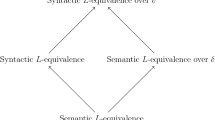Abstract
Kyle Stanford’s arguments against scientific realism are assessed, with a focus on the underdetermination of theory by evidence. I argue that discussions of underdetermination have neglected a possible symmetry which may ameliorate the situation.
Similar content being viewed by others
Notes
Perhaps there are two categories to consider here, which Stanford and I treat together. One, a pure form of eliminative inference, is a “last man standing” approach. It does not matter how good, in its own terms, a theory is, so long as it is at least possible; its credibility comes from the fact that all the others are ruled out. Someone who was very skeptical about positive concepts of confirmation and support could use such inferences. The other category involves more of a mixture. Here we have a theory with some positive virtues in its own right, but that can also be seen to be doing much better than any other option. This kind of inference is contrastive without being eliminative (and fits naturally into a Bayesian context). Stanford is mostly discussing cases with this mixed and contrastive character.
Stanford argues at one point that it would be odd to claim that present-day individuals have different imaginative powers from people in earlier times. This is supposed to blunt some possible objections from the immaturity of the science. Stanford’s argument, he says, is about human powers, which can be assumed to be fairly stable. But this issue is transformed when we consider the role of community level properties. It may be that present-day communities have developed better ways of harnessing the fixed powers of individual imagination.
Here is an informal statement of the corresponding pair of principles in the Bayesian case: Glass half full for Bayesian updating—Suppose two agents see the same evidence, assume the same likelihoods for that evidence on all hypotheses, and update properly on that evidence. Then for any given amount of initial distance between two agents’ degrees of belief in h, and any measure of “closeness” you choose, there is some body of evidence after which the two agents’ degrees of belief in h will be close. Glass half empty for Bayesian updating—Suppose two agents see the same evidence, assume the same likelihoods for that evidence on all hypotheses, and update properly on that evidence. Then for any amount of data, and any measure of “closeness” you choose, there is some initial distance between the two agents’ degrees of belief in h such that after that amount of evidence the two agents’ degrees of belief in h will not be close.
Complexities arise immediately. The most important concern the relation between closeness to truth (in the initial sense above) and information content. An overall score for a theory should be high when it picks out worlds close to actuality, and does not achieve this by covering a large part of logical space, ruling very little out. These considerations of information content do affect the discussion below in several ways, but for simplicity I will ignore them in this discussion.
I am idealizing away from changes in information content, and that does matter here. See footnote 4.
References
Godfrey-Smith, P. (2003). Theory and reality: An introduction to the philosophy of science. Chicago: University of Chicago Press.
Godfrey-Smith, P. (forthcoming). Popper’s philosophy of science: Looking ahead. Cambridge Companion to Karl Popper (to appear).
Hilpinen, R. (1976). Approximate truth and truthlikeness. In M. Przelecki et al. (Eds.), Formal methods in the methodology of the empirical sciences. Dordrecht: Reidel.
Hull, D. (1988). Science as a process. Chicago: University of Chicago Press.
Kitcher, P. S. (1993). The advancement of science. Oxford: Oxford University Press.
Kuhn, T. S. (1970). The structure of scientific revolutions (2nd ed.). Chicago: University of Chicago Press.
Oddie, G. (2001). Truthlikeness. In Stanford encyclopedia of philosophy. http://www.plato.stanford.edu/entries/truthlikeness/
Psillos, S. (1999). Scientific realism: How science tracks truth. London: Routledge.
Stanford, K. (2006). Exceeding our grasp: Science, history, and the problem of unconceived alternatives. Oxford: Oxford University Press.
Strevens, M. (2003). The role of the priority rule in science. Journal of Philosophy, 100, 55–79.
Tichý, P. (1974). On Popper’s definitions of verisimilitude. The British Journal for the Philosophy of Science, 25, 155–160.
Author information
Authors and Affiliations
Corresponding author
Additional information
Presented at the Pacific APA, 2007. Version F.
Rights and permissions
About this article
Cite this article
Godfrey-Smith, P. Recurrent transient underdetermination and the glass half full. Philos Stud 137, 141–148 (2008). https://doi.org/10.1007/s11098-007-9172-2
Accepted:
Published:
Issue Date:
DOI: https://doi.org/10.1007/s11098-007-9172-2



